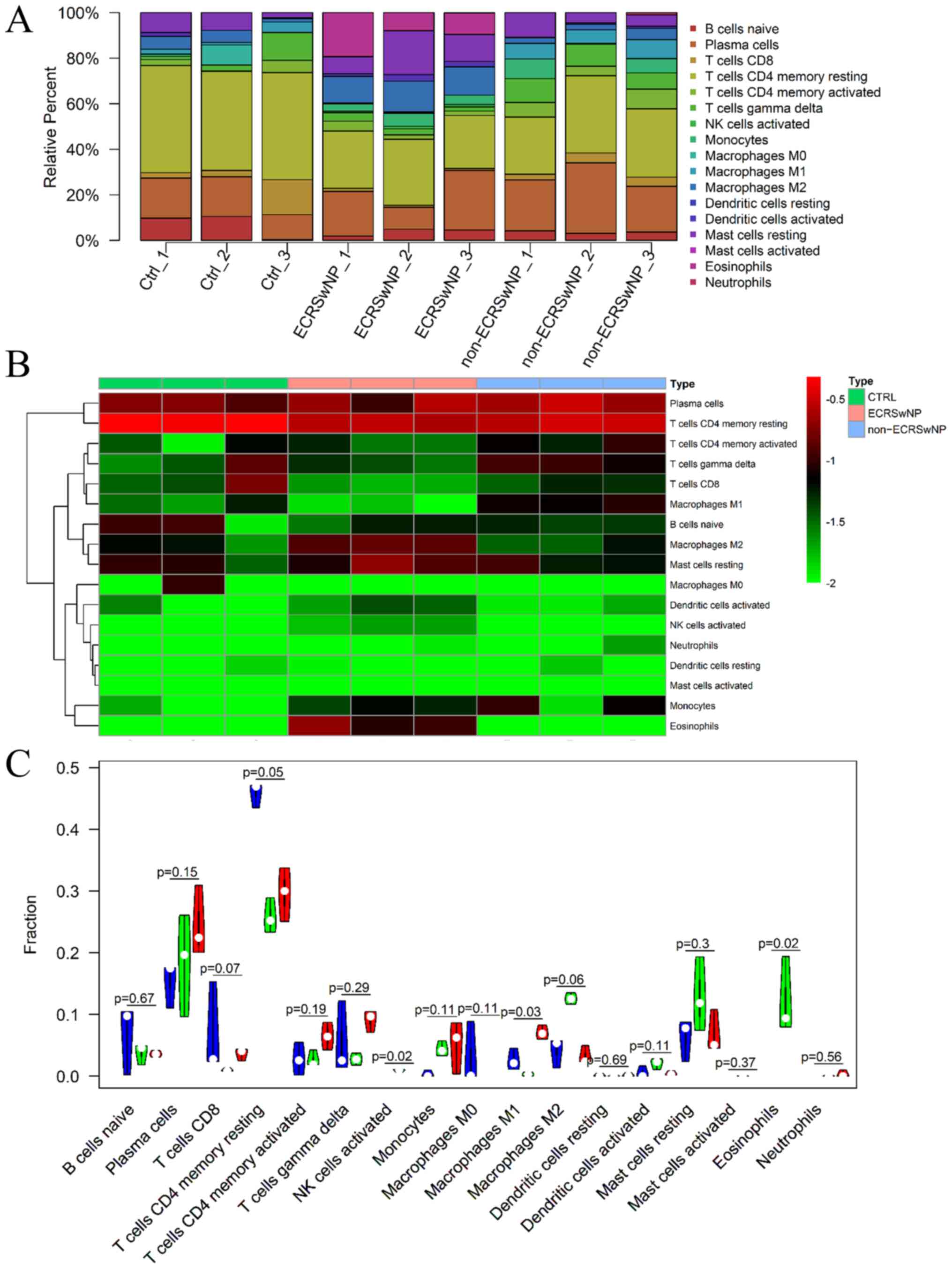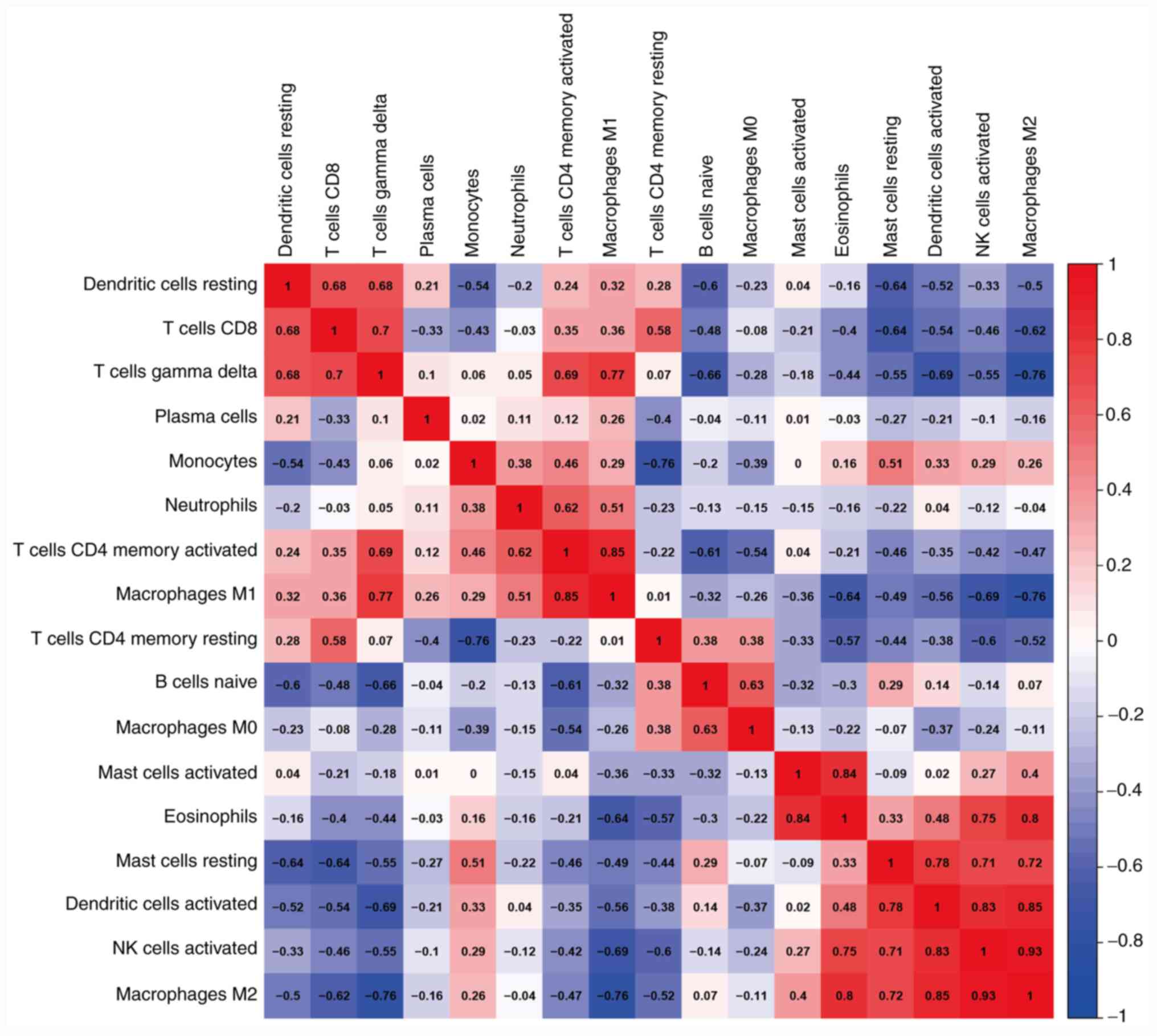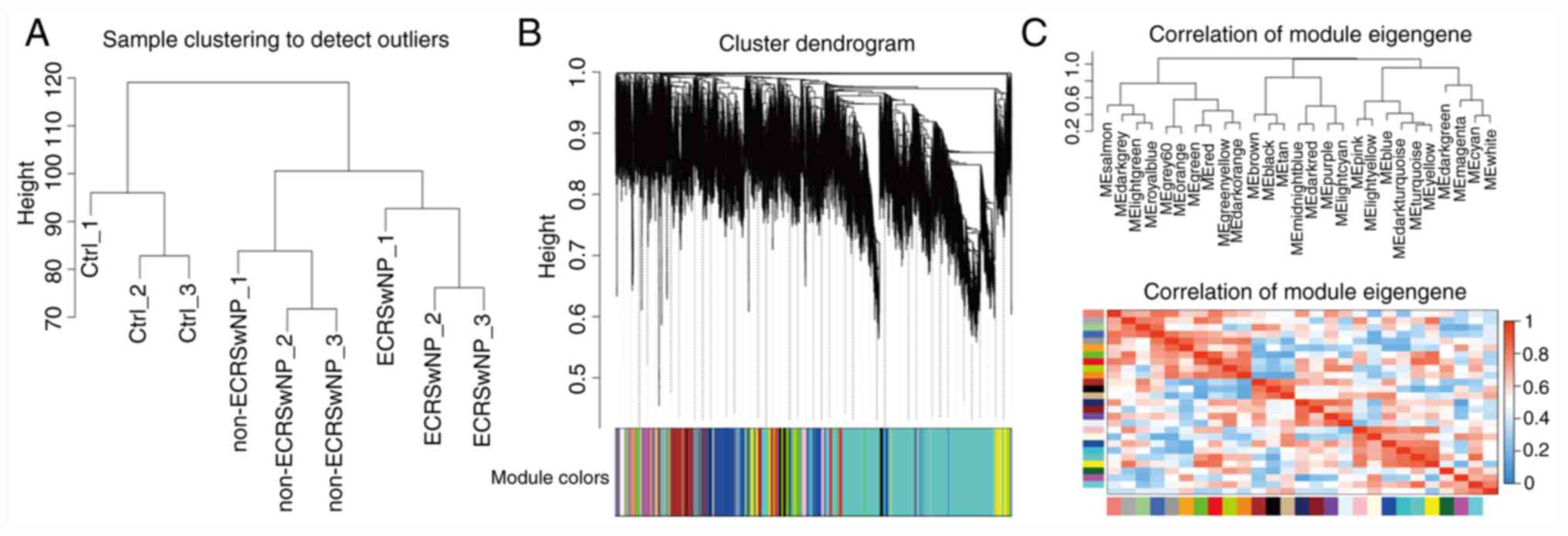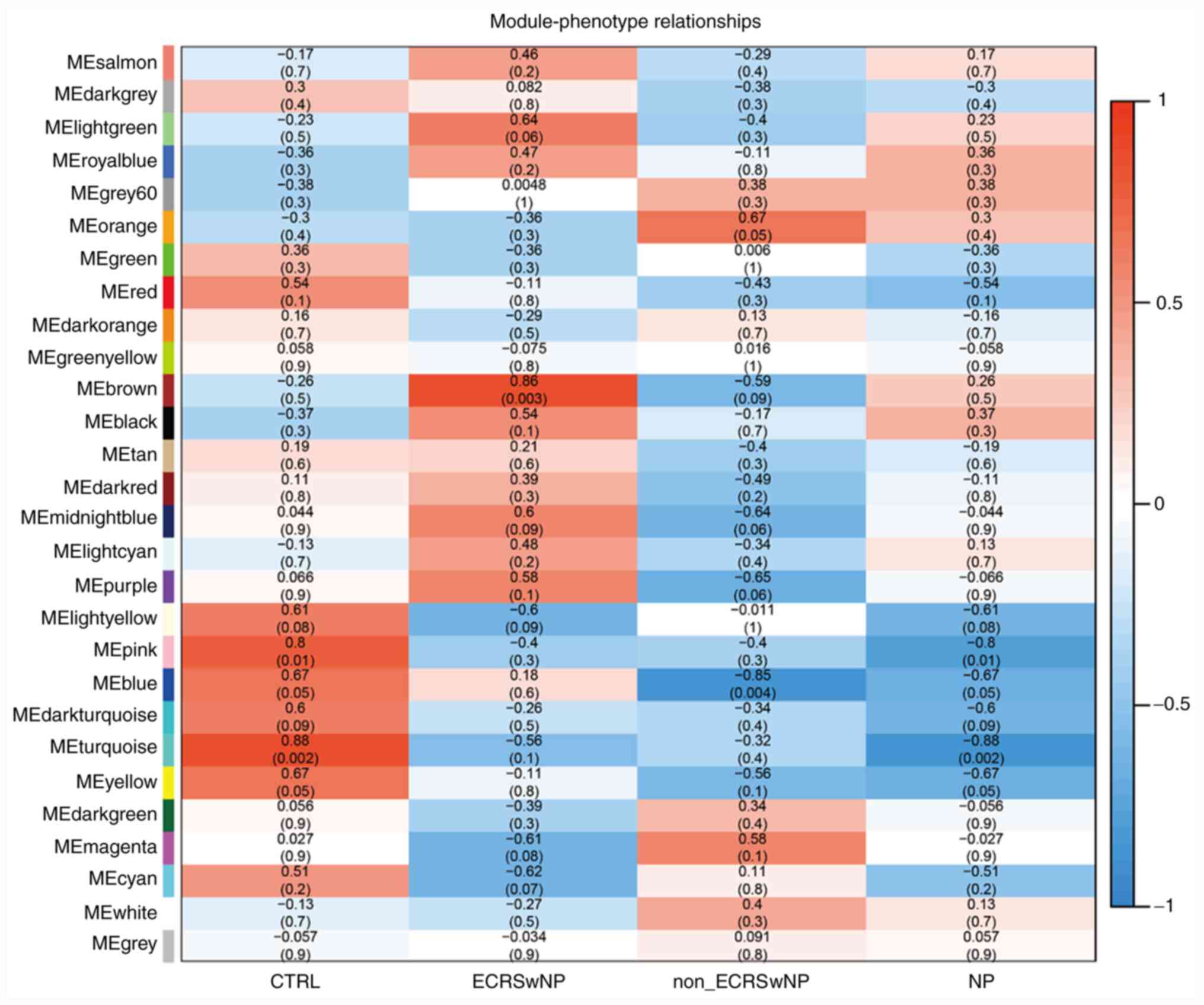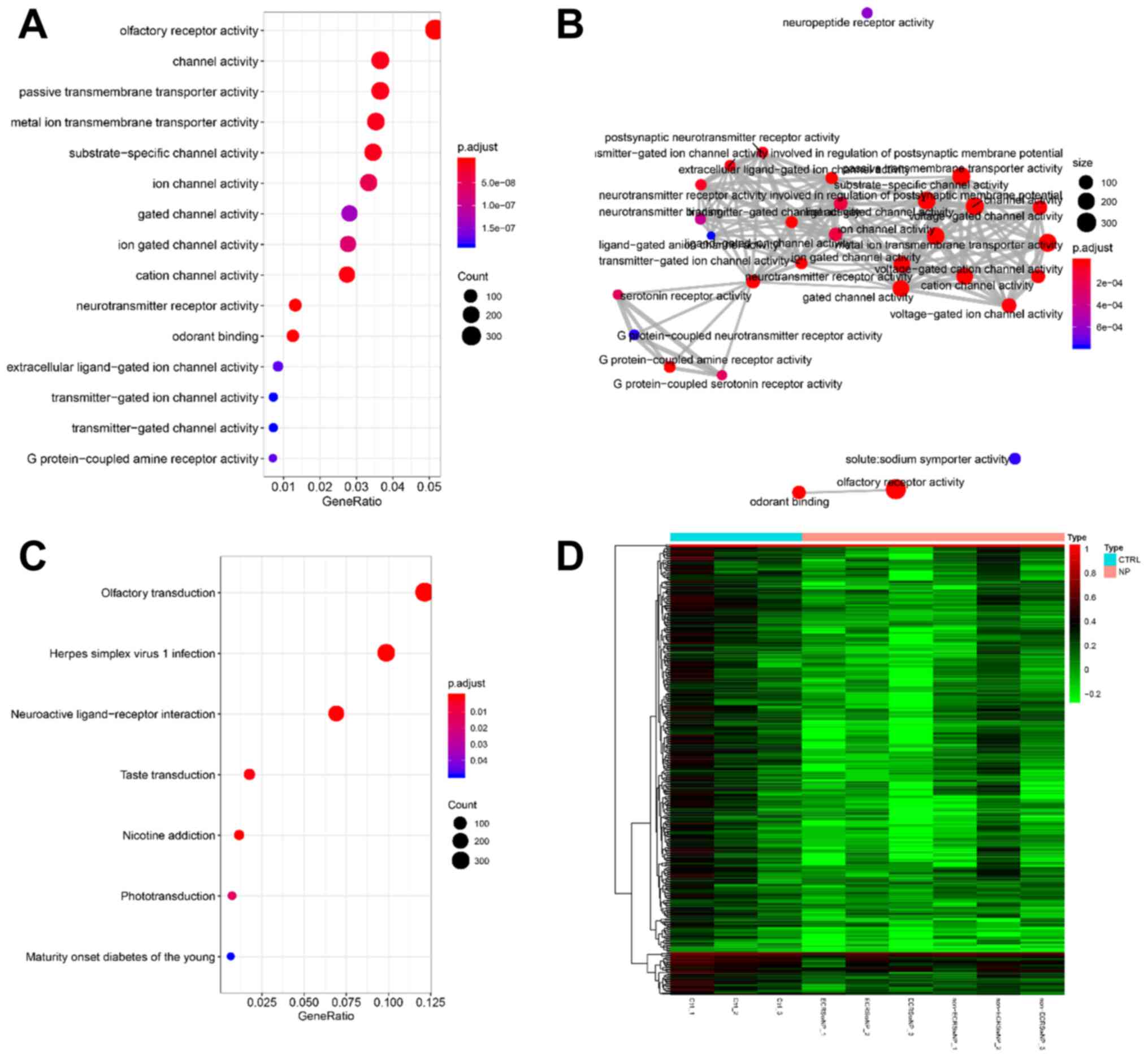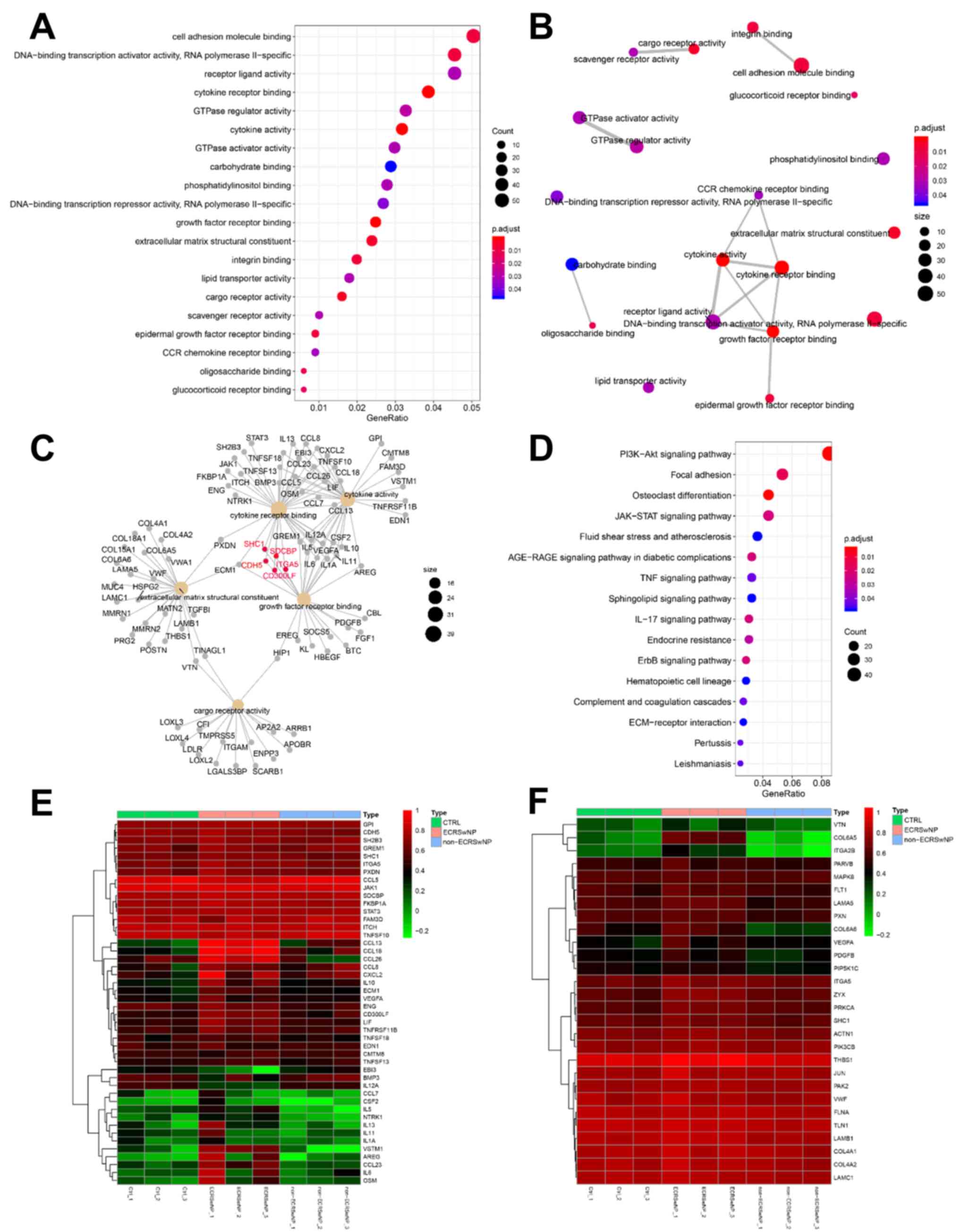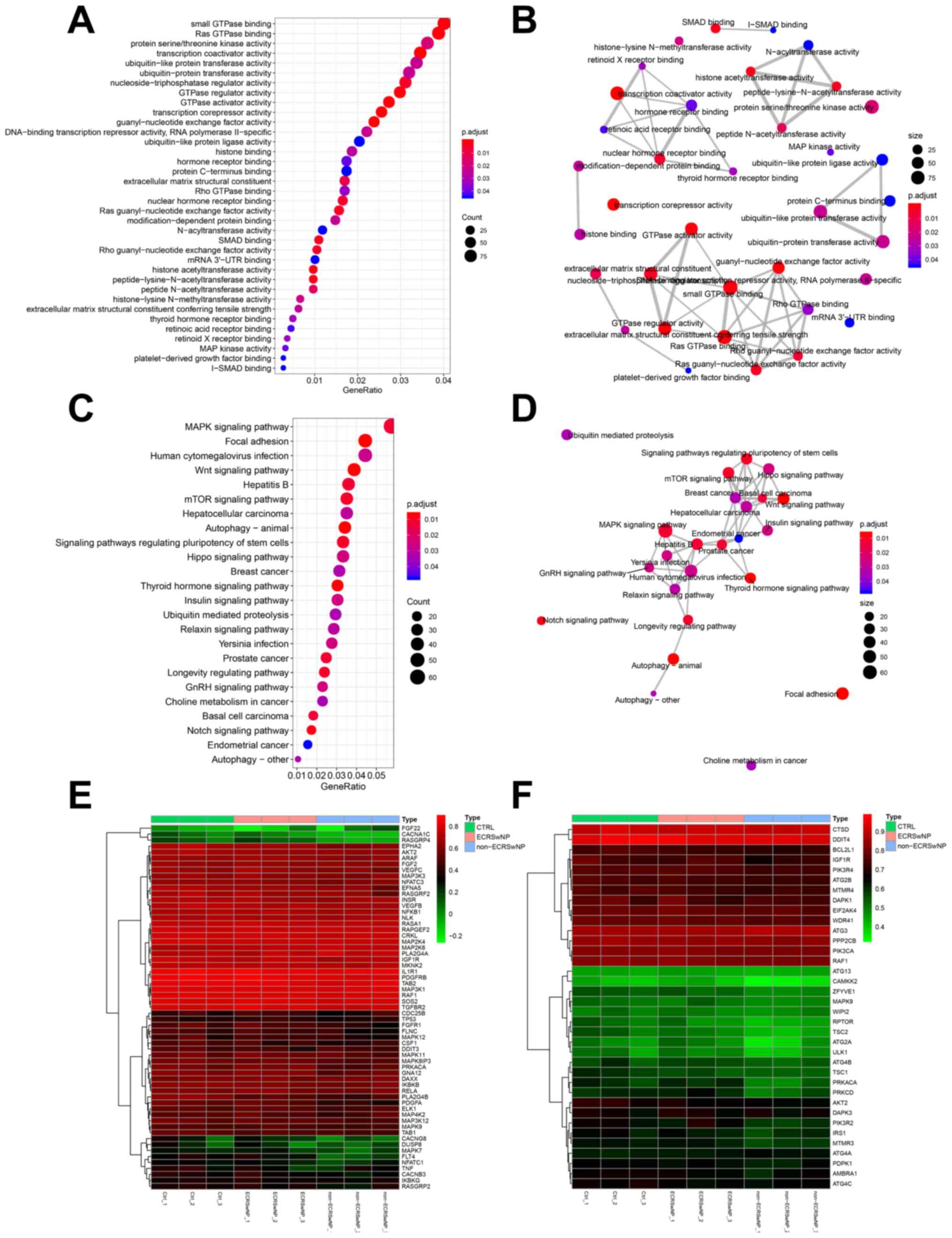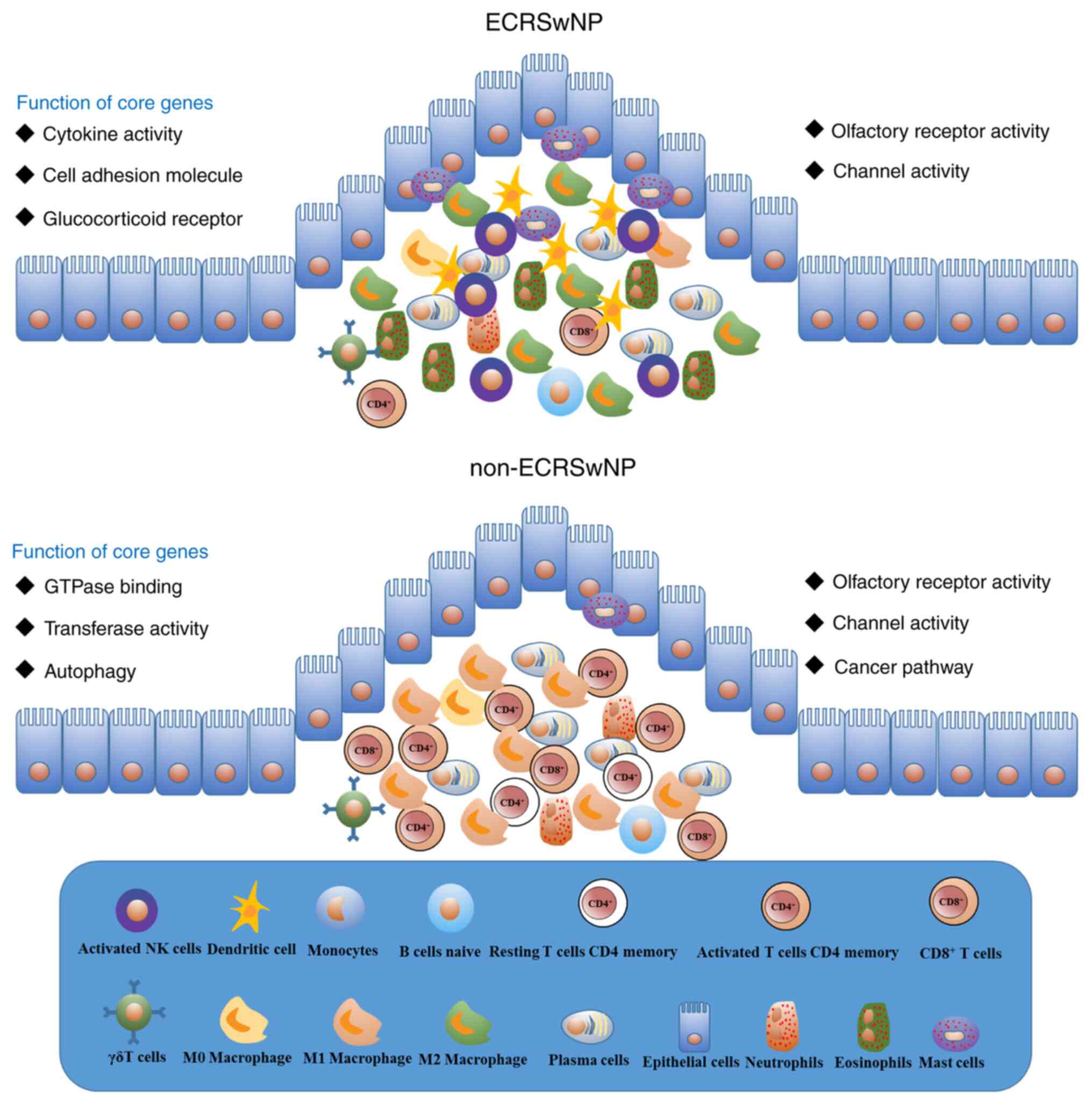|
1
|
Fokkens WJ, Lund VJ, Mullol J, Bachert C,
Alobid I, Baroody F, Cohen N, Cervin A, Douglas R, Gevaert P, et
al: European position paper on rhinosinusitis and nasal polyps
2012. Rhinol Suppl. 23:1–298. 2012.PubMed/NCBI View Article : Google Scholar
|
|
2
|
Kwah JH and Peters AT: Nasal polyps and
rhinosinusitis. Allergy Asthma Proc. 40:380–384. 2019.PubMed/NCBI View Article : Google Scholar
|
|
3
|
Schleimer RP: Immunopathogenesis of
chronic rhinosinusitis and nasal polyposis. Annu Rev Pathol.
12:331–357. 2017.PubMed/NCBI View Article : Google Scholar
|
|
4
|
Meltzer EO, Hamilos DL, Hadley JA, Lanza
DC, Marple BF, Nicklas RA, Bachert C, Baraniuk J, Baroody FM,
Benninger MS, et al: Rhinosinusitis: Establishing definitions for
clinical research and patient care. J Allergy Clin Immunol.
114:155–212. 2004.PubMed/NCBI View Article : Google Scholar
|
|
5
|
Soler ZM, Sauer D, Mace J and Smith TL:
Impact of mucosal eosinophilia and nasal polyposis on quality-of
life outcomes after sinus surgery. Otolaryngol Head Neck Surg.
142:64–71. 2010.PubMed/NCBI View Article : Google Scholar
|
|
6
|
Vlaminck S, Vauterin T, Hellings PW,
Jorissen M, Acke F, Van Cauwenberge P, Bachert C and Gevaert P: The
importance of local eosinophilia in the surgical outcome of chronic
rhinosinusitis: A 3-year prospective observational study. Am J
Rhinol Allergy. 28:260–264. 2014.PubMed/NCBI View Article : Google Scholar
|
|
7
|
Wang X, Zhang Bo M, Holtappels G, Zheng M,
Lou H, Wang H, Zhang L and Bachert C: Diversity of TH cytokine
profiles in patients with chronic rhinosinusitis: A multicenter
study in Europe, Asia, and Oceania. J Allergy Clin Immunol.
138:1344–1353. 2016.PubMed/NCBI View Article : Google Scholar
|
|
8
|
Lou H, Meng Y, Piao Y, Wang C, Zhang L and
Bachert C: Predictive significance of tissue eosinophilia for nasal
polyp recurrence in the Chinese population. Am J Rhinol Allergy.
29:350–356. 2015.PubMed/NCBI View Article : Google Scholar
|
|
9
|
Nakayama T, Yoshikawa M, Asaka D, Okushi
T, Matsuwaki Y, Otori N, Hama T and Moriyama H: Mucosal
eosinophilia and recurrence of nasal polyps-new classification of
chronic rhinosinusitis. Rhinology. 49:392–396. 2011.PubMed/NCBI View Article : Google Scholar
|
|
10
|
Cho SW, Kim DW, Kim JW, Lee CH and Rhee
CS: Classification of chronic rhinosinusitis according to a nasal
polyp and tissue eosinophilia: Limitation of current classification
system for Asian population. Asia Pac Allergy. 7:121–130.
2017.PubMed/NCBI View Article : Google Scholar
|
|
11
|
Zhang N, Van Zele T, Perez-Novo C, Van
Bruaene N, Holtappels G, DeRuyck N, Van Cauwenberge P and Bachert
C: Different types of T-effector cells orchestrate mucosal
inflammation in chronic sinus disease. J Allergy Clin Immunol.
122:961–968. 2008.PubMed/NCBI View Article : Google Scholar
|
|
12
|
Katotomichelakis M, Tantilipikorn P,
Holtappels G, De Ruyck N, Feng L, Van Zel T, Muangsomboon S,
Jareonchasri P, Bunnag C, Danielides V, et al: Inflammatory
patterns in upper airway disease in the same geographical area may
change over time. Am J Rhinol Allergy. 27:354–360. 2013.PubMed/NCBI View Article : Google Scholar
|
|
13
|
Sakuma Y, Ishitoya J, Komatsu M, Shiono O,
Hirama M, Yamashita Y, Kaneko T, Morita S and Tsukuda M: New
clinical diagnostic criteria for eosinophilic chronic
rhinosinusitis. Auris Nasus Larynx. 38:583–588. 2011.PubMed/NCBI View Article : Google Scholar
|
|
14
|
Cao PP, Li HB, Wang BF, Wang SB, You XJ,
Cui YH, Wang DY, Desrosiers M and Liu Z: Distinct immunopathologic
characteristics of various types of chronic rhinosinusitis in adult
Chinese. J Allergy Clin Immunol. 124:478–484. 2009.PubMed/NCBI View Article : Google Scholar
|
|
15
|
Wang ZC, Yao Y, Wang N, Liu JX, Ma J, Chen
CL, Deng YK, Wang MC, Liu Y, Zhang XH and Liu Z: Deficiency in
interleukin-10 production by M2 macrophages in eosinophilic chronic
rhinosinusitis with nasal polyps. Int Forum Allergy Rhinol.
8:1323–1333. 2018.PubMed/NCBI View Article : Google Scholar
|
|
16
|
Perić A, Baletić N, Sotirović J and
Špadijer-Mirković C: Macrophage inflammatory protein-1 production
and eosinophil infiltration in chronic rhinosinusitis with nasal
polyps. Ann Otol Rhinol Laryngol. 124:266–272. 2015.PubMed/NCBI View Article : Google Scholar
|
|
17
|
Bachert C, Wagenmann M, Hauser U and
Rudack C: IL-5 synthesis is upregulated in human nasal polyp
tissue. J Allergy Clin Immunol. 99:837–842. 1997.PubMed/NCBI View Article : Google Scholar
|
|
18
|
Meyer JE, Bartels J, Görögh T, Sticherling
M, Rudack C, Ross DA and Maune S: The role of RANTES in nasal
polyposis. Am J Rhinol. 19:15–20. 2005.PubMed/NCBI
|
|
19
|
Okada N, Nakayama T, Asaka D, Inoue N,
Tsurumoto T, Takaishi S, Otori N, Kojima H, Matsuda A, Oboki K, et
al: Distinct gene expression profiles and regulation networks of
nasal polyps in eosinophilic and non-eosinophilic chronic
rhinosinusitis. Int Forum Allergy Rhinol. 8:592–604.
2018.PubMed/NCBI View Article : Google Scholar
|
|
20
|
Wang W, Gao Z, Wang H, Li T, He W, Lv W
and Zhang J: Transcriptome analysis reveals distinct gene
expression profiles in eosinophilic and noneosinophilic chronic
rhinosinusitis with nasal polyps. Sci Rep. 6(26604)2016.PubMed/NCBI View Article : Google Scholar
|
|
21
|
Newman AM, Liu CL, Green MR, Gentles AJ,
Feng W, Xu Y, Hoang CD, Diehn M and Alizadeh AA: Robust enumeration
of cell subsets from tissue expression profiles. Nat Methods.
12:453–457. 2015.PubMed/NCBI View Article : Google Scholar
|
|
22
|
Wei TY and Simko V: R package ‘corrplot’:
Visualization of a Correlation Matrix (version 0.84). urihttps://github.com/taiyun/corrplotsimplehttps://github.com/taiyun/corrplot.
|
|
23
|
Langfelder P and Horvath S: WGCNA: An R
package for weighted correlation network analysis. BMC
Bioinformatics. 9(559)2008.PubMed/NCBI View Article : Google Scholar
|
|
24
|
Zhang B and Horvath S: A general framework
for weighted gene co-expression network analysis. Stat Appl Genet
Mol Biol. 4(17)2005.PubMed/NCBI View Article : Google Scholar
|
|
25
|
Langfelder P, Zhang B and Horvath S:
Defining clusters from a hierarchical cluster tree: The dynamic
tree cut package for R. Bioinformatics. 24:719–720. 2008.PubMed/NCBI View Article : Google Scholar
|
|
26
|
Livak KJ and Schmittgen TD: Analysis of
relative gene expression data using real-time quantitative PCR and
the 2(-Delta Delta C(T)) method. Methods. 25:402–408.
2001.PubMed/NCBI View Article : Google Scholar
|
|
27
|
Yu G, Wang LG, Han Y and He QY:
ClusterProfiler: An R package for comparing biological themes among
gene clusters. OMICS. 16:284–287. 2012.PubMed/NCBI View Article : Google Scholar
|
|
28
|
MacLeod MK, Clambey ET, Kappler JW and
Marrack P: CD4 memory T cells: What are they and what can they do?
Semin Immunol. 21:53–61. 2009.PubMed/NCBI View Article : Google Scholar
|
|
29
|
Turner DL, Bickham KL, Thome JJ, Kim CY,
D'Ovidio F, Wherry EJ and Farber DL: Lung niches for the generation
and maintenance of tissue-resident memory T cells. Mucosal Immunol.
7:501–510. 2014.PubMed/NCBI View Article : Google Scholar
|
|
30
|
Teijaro JR, Turner D, Pham Q, Wherry EJ,
Lefrançois L and Farber DL: Cutting edge: Tissue-Retentive lung
memory CD4 T cells mediate optimal protection to respiratory virus
infection. J Immunol. 187:5510–5514. 2011.PubMed/NCBI View Article : Google Scholar
|
|
31
|
Nakanishi Y, Lu B, Gerard C and Iwasaki A:
CD8(+) T lymphocyte mobilization to virus-infected tissue requires
CD4(+) T-cell help. Nature. 462:510–513. 2009.PubMed/NCBI View Article : Google Scholar
|
|
32
|
Shenoy AT, Wasserman GA, Arafa EI, Wooten
AK, Smith NM, Martin IM, Jones MR, Quinton LJ and Mizgerd JP: Lung
CD4+ resident memory T cells remodel epithelial responses to
accelerate neutrophil recruitment during pneumonia. Mucosal
Immunol. 13:334–343. 2019.PubMed/NCBI View Article : Google Scholar
|
|
33
|
Wu D, Wang J and Zhang M: Altered
Th17/Treg ratio in nasal polyps with distinct cytokine profile
association with patterns of inflammation and mucosal remodeling.
Medicine (Baltimore). 95(e2998)2016.PubMed/NCBI View Article : Google Scholar
|
|
34
|
Bonneville M, O'Brien RL and Born WK:
Gammadelta T cell effector functions: A blend of innate programming
and acquired plasticity. Nat Rev Immunol. 10:467–478.
2010.PubMed/NCBI View Article : Google Scholar
|
|
35
|
Shapouri-Moghaddam A, Mohammadian S,
Vazini H, Taghadosi M, Esmaeili SA, Mardani F, Seifi B, Mohammadi
A, Afshari JT and Sahebkar A: Macrophage plasticity, polarization,
and function in health and disease. J Cell Physiol. 233:6425–6440.
2018.PubMed/NCBI View Article : Google Scholar
|
|
36
|
Hua X, Naselsky WC, Jania CM, Chason KD,
Huang JJ, Doerschuk CM, Graham SM, Senior BA and Tilley SL: Mast
cell deficiency limits the development of chronic rhinosinusitis in
mice. Ann Otol Rhinol Laryngol. 125:290–296. 2016.PubMed/NCBI View Article : Google Scholar
|
|
37
|
Gröger M, Bernt A, Wolf M, Mack B,
Pfrogner E, Becker S and Kramer MF: Eosinophils and mast cells: A
comparison of nasal mucosa histology and cytology to markers in
nasal discharge in patients with chronic sino-nasal diseases. Eur
Arch Otorhinolaryngol. 270:2667–2676. 2013.PubMed/NCBI View Article : Google Scholar
|
|
38
|
Kim JH, Choi GE, Lee BJ, Kwon SW, Lee SH,
Kim HS and Jang YJ: Natural killer cells regulate eosinophilic
inflammation in chronic rhinosinusitis. Sci Rep.
6(27615)2016.PubMed/NCBI View Article : Google Scholar
|
|
39
|
Gelardi M, Piccininni K, Quaranta N,
Quaranta V, Silvestri M and Ciprandi G: Olfactory dysfunction in
patients with chronic rhinosinusitis with nasal polyps is
associated with clinical-cytological grading severity. Acta
Otorhinolaryngol Ital. 39:329–335. 2019.PubMed/NCBI View Article : Google Scholar
|
|
40
|
Lavin J, Min JY, Lidder AK, Huang JH, Kato
A, Lam K, Meen E, Chmiel JS, Norton J, Suh L, et al: Superior
turbinate eosinophilia correlates with olfactory deficit in chronic
rhinosinusitis patients. Laryngoscope. 127:2210–2218.
2017.PubMed/NCBI View Article : Google Scholar
|
|
41
|
Shah SA, Ishinaga H and Takeuchi K:
Pathogenesis of eosinophilic chronic rhinosinusitis. J Inflamm
(Lond). 13(11)2016.PubMed/NCBI View Article : Google Scholar
|
|
42
|
Clutterbuck E, Shields JG, Gordon J, Smith
SH, Boyd A, Callard RE, Campbell HD, Young IG and Sanderson CJ:
Recombinant human interleukin 5 is an eosinophil differentiation
factor but has no activity in standard human B cell growth factor
assays. Eur J Immunol. 17:1743–1750. 1987.PubMed/NCBI View Article : Google Scholar
|
|
43
|
Clutterbuck EJ, Hirst EM and Sanderson CJ:
Human interleukin-5 (IL-5) regulates the production of eosinophils
in human bone marrow cultures: Comparison and interaction with
IL-1, IL-3, IL-6, and GMCSF. Blood. 73:1504–1512. 1989.PubMed/NCBI
|
|
44
|
Clutterbuck EJ and Sanderson CJ:
Regulation of human eosinophil precursor production by cytokines: A
comparison of recombinant human interleukin-1 (rhIL-1), rhIL-3,
rhIL-5, rhIL-6, and rh granulocyte-macrophage colony-stimulating
factor. Blood. 75:1774–1779. 1990.PubMed/NCBI
|
|
45
|
Sauter A, Stern-Straeter J, Chang RC,
Hörmann K and Naim R: Influence of interleukin-13 on beta-catenin
levels in eosinophilic chronic rhinosinusitis cell culture. Int J
Mol Med. 21:447–452. 2008.PubMed/NCBI
|
|
46
|
Novak N and Donald YM: Role of barrier
dysfunction and immune response in atopic dermatitis. In: Pediatric
Allergy: Principles and Practice. 3rd edition. Elsevier, pp438-447,
2016.
|
|
47
|
Alobid I and Mullol J: Role of medical
therapy in the management of nasal polyps. Curr Allergy Asthma Rep.
12:144–153. 2012.PubMed/NCBI View Article : Google Scholar
|
|
48
|
Takeda K, Takeno S, Hirakawa K and Ishino
T: Expression and distribution of glucocorticoid receptor isoforms
in eosinophilic chronic rhinosinusitis. Auris Nasus Larynx.
37:700–707. 2010.PubMed/NCBI View Article : Google Scholar
|
|
49
|
Pujols L, Mullol J, Benítez P, Torrego A,
Xaubet A, de Haro J and Picado C: Expression of the glucocorticoid
receptor alpha and beta isoforms in human nasal mucosa and polyp
epithelial cells. Respir Med. 97:90–96. 2003.PubMed/NCBI View Article : Google Scholar
|
|
50
|
Wang H, Bai J, Ding M, Liu W, Xu R, Zhang
J, Shi J and Li H: Interleukin-17A contributes to the expression of
serum amyloid A in chronic rhinosinusitis with nasal polyps. Eur
Arch Otorhinolaryngol. 270:1867–1872. 2013.PubMed/NCBI View Article : Google Scholar
|
|
51
|
He R, Sang H and Ye RD: Serum amyloid A
induces IL-8 secretion through a G protein-coupled receptor,
FPRL1/LXA4R. Blood. 101:1572–1581. 2003.PubMed/NCBI View Article : Google Scholar
|
|
52
|
Choi GE, Yoon SY, Kim JY, Kang DY, Jang YJ
and Kim HS: Autophagy deficiency in myeloid cells exacerbates
eosinophilic inflammation in chronic rhinosinusitis. J Allergy Clin
Immunol. 141:938–950. 2018.PubMed/NCBI View Article : Google Scholar
|
|
53
|
Wang BF, Cao PP, Wang ZC, Li ZY, Wang ZZ,
Ma J, Liao B, Deng YK, Long XB, Xu K, et al: Interferon-γ-induced
insufficient autophagy contributes to p62-dependent apoptosis of
epithelial cells in chronic rhinosinusitis with nasal polyps.
Allergy. 72:1384–1397. 2017.PubMed/NCBI View Article : Google Scholar
|















